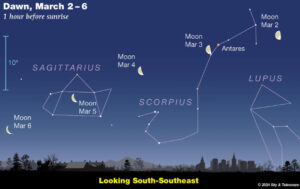Special to CosmicTribune.com, February 26, 2024
Excerpts from weekly Sky&Telescope report.
SUNDAY, FEBRUARY 25
■ Another way Sirius is special: it’s the bottom star of the bright, equilateral Winter Triangle. The other two stars of the Triangle are orange Betelgeuse to Sirius’s upper right (Orion’s shoulder) and Procyon to Sirius’s upper left. The Winter Triangle perfectly balances on Sirius in early evening.
 TUESDAY, FEBRUARY 27
TUESDAY, FEBRUARY 27
■ This is a fine week to look for the zodiacal light if you live in the mid-northern latitudes, now that the early-evening sky is moonless and the ecliptic is tilting high upward from the western horizon at nightfall. From a clear, clean-aired dark site, look west at the very end of twilight for a vague but huge, tall pyramid of pearly light. It’s tilted to the left, aligned along constellations of the zodiac.
What you’re seeing is sunlit interplanetary dust orbiting the Sun near the ecliptic plane.
WEDNESDAY, FEBRUARY 28
■ After dinnertime at this time of year, five carnivore constellations are rising upright in a row from the northeast to south. They’re all presented in profile with their noses pointed up and their feet (if any) to the right. These are Ursa Major the Big Bear in the northeast (with the Big Dipper as its brightest part), Leo the Lion in the east, Hydra the Sea Serpent in the southeast, Canis Minor the Little Dog higher in the south-southeast, and bright Canis Major the Big Dog in the south.
THURSDAY, FEBRUARY 29
■ High in the northern sky these evenings, in the seemingly empty wastes between Capella overhead and Polaris due north, sprawls big, dim Camelopardalis, the Giraffe — perhaps the biggest often-visible constellation you don’t know.
FRIDAY, MARCH 1
■ Sirius blazes high in the south on the meridian by about 8 p.m. now. Using binoculars or a scope at low power, examine the spot 4° south of it (directly below it when on the meridian). Four degrees is somewhat less than the width of a typical binocular’s or finderscope’s field of view. Can you see a little patch of speckly gray haze? That’s the open star cluster M41, about 2,300 light-years away. Its total magnitude adds up to 5.0.
Sirius, by comparison, is only 8.6 light-years away — and being so near, it shines some 400 times brighter than the entire cluster.
■ Late these moonless evenings, as Ursa Major climbs high in the northeast, go on a telescopic galaxy hunt in and around its star pattern.
SATURDAY, MARCH 2
■ The last-quarter Moon rises around 1 or 2 a.m. tonight. (It’s exactly last quarter at 10:23 a.m. EST Sunday morning.) The rising Moon shines very close to Antares, especially as seen from the East Coast. In fact the Moon occults Antares soon after rising as seen from much of the American South and Midwest.
Map and timetables for this event. The first two tables, for many cities, are very long. The first gives the times of Antares’s disappearance behind the Moon’s bright limb; the second its reappearance out from behind the Moon’s dark limb. Scroll to be sure you’re using the correct table; watch for the new heading as you scroll down. The first two letters in each entry are the country abbreviation. The times are in UT (GMT) March 3rd. UT is 5 hours ahead of Eastern Standard Time, 6 hours ahead of CST, 7 ahead of MST, and 8 ahead of PST.
For instance: Use the first table to see that for Atlanta, Antares disappears on the bright limb at 2:04 a.m. March 3rd EST when the Moon is only 4° high in the east-southeast (azimuth 126°). Then it reappears from behind the dark limb at 2:56 a.m. EST when the Moon is 13° high in the southeast. The latter is clearly the better event!
By dawn on the 3rd, the Moon has moved farther to Antares’s east. In the summer-preview sky that we see before dawn, the waning Moon crosses Scorpius and Sagittarius.
SUNDAY, MARCH 3
■ Look east after dusk this week for the constellation Leo already climbing well up the sky. Its brightest star is Regulus. The Sickle of Leo (about a fist and a half tall) extends upper left from there.
■ These moonless nights are a fine time to collect some telescopic triple stars with Bob King’s new guide to 17 of them: Winter’s Finest Triple Stars, with finder charts and data about each trio.

You must be logged in to post a comment Login